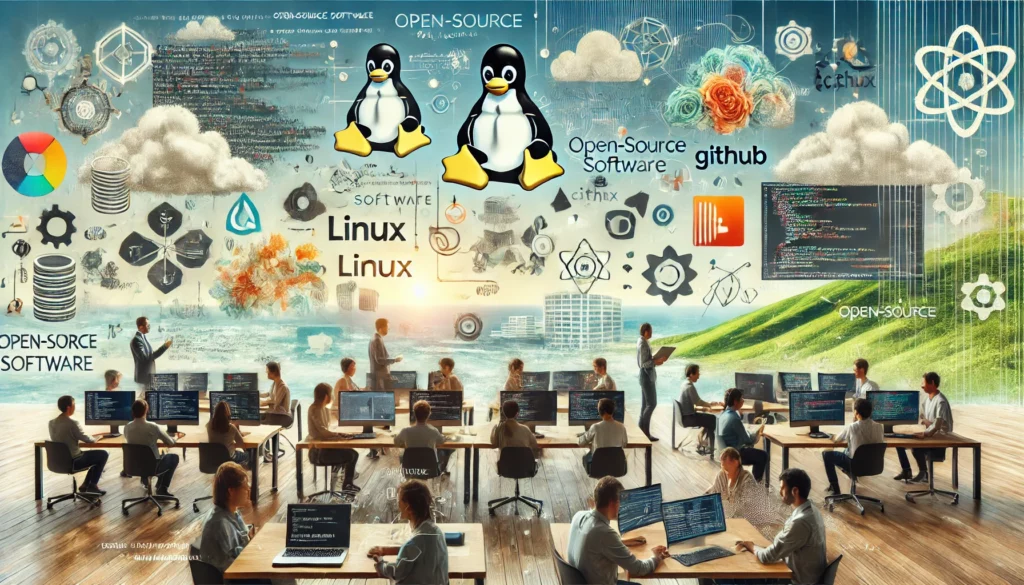Table of Contents
In an era where technology permeates every aspect of our lives, the foundation of modern computing continues to evolve at an unprecedented pace. At the heart of this evolution lies a powerful force that has fundamentally transformed how software is developed, distributed, and utilized: open-source software (OSS). According to Toptechnews, unlike proprietary software, which keeps its source code hidden and restricted, open-source software embraces transparency, collaboration, and community-driven development. This revolutionary approach to software development has become a cornerstone of innovation, fostering a global ecosystem of developers, organizations, and users who collectively shape the future of technology.
What is Open-Source Software?
Open-source software represents more than just freely available programs—it embodies a philosophy of openness, collaboration, and shared progress. At its core, OSS grants users the freedom to view, modify, and distribute the source code under specific licensing terms. This transparency creates an environment where developers worldwide can inspect, enhance, and build upon existing solutions.
The open-source landscape is rich with successful projects that have become integral to our digital infrastructure. Linux, the operating system that powers most of the internet’s servers and the Android platform, stands as a testament to the potential of open-source development. The Apache web server, which hosts a significant portion of websites worldwide, and Python, a programming language that drives scientific computing and artificial intelligence, exemplify how OSS has become the backbone of modern technology stacks.

The Historical Context of Open-Source Software
The journey of open-source software began in the early 1980s when Richard Stallman launched the GNU Project, establishing the Free Software Foundation and introducing the concept of “free software.” This movement wasn’t just about cost—it was about freedom: the freedom to run, study, modify, and share software. The advent of Linux in 1991, created by Linus Torvalds, marked a pivotal moment in OSS history, demonstrating that a community of volunteers could create sophisticated software rivaling commercial alternatives.
The rise of distributed version control systems and platforms like GitHub has revolutionized collaborative development, making it easier than ever for developers worldwide to contribute to projects. This evolution has transformed software development from a closed, company-specific activity into a global, community-driven endeavor.
Key Benefits of Open-Source Software
Cost-Effectiveness
The financial advantages of open-source software extend far beyond the initial cost savings. Organizations can redirect funds from software licensing to customization, support, and innovation. Startups particularly benefit from this model, as they can build sophisticated technology stacks without substantial upfront investments. Companies like Instagram and Spotify initially built their platforms using open-source technologies, demonstrating how OSS can enable rapid scaling while maintaining cost efficiency.
Security and Transparency
The transparent nature of open-source software creates a unique security advantage through collective scrutiny. When vulnerabilities are discovered, the global developer community often responds rapidly with patches and updates. The Linux kernel’s security track record exemplifies this advantage—thousands of developers regularly review the code, identifying and fixing potential security issues before they can be exploited.
Flexibility and Customization
Open-source software provides unparalleled flexibility, allowing organizations to modify solutions to meet their specific needs. Netflix, for instance, has extensively customized open-source tools to handle its massive streaming infrastructure. Similarly, financial institutions have adapted open-source databases and analytics tools to meet strict regulatory requirements while maintaining high performance.
Community-Driven Innovation
The collaborative nature of open-source development accelerates innovation through shared knowledge and resources. TensorFlow, Google’s open-source machine learning framework, has evolved rapidly thanks to contributions from researchers and developers worldwide. This collective effort has led to breakthroughs in artificial intelligence applications across various industries.
Open-Source Software in Key Industries
Education
Educational institutions worldwide leverage open-source solutions to provide quality education at scale. Moodle, an open-source learning management system, serves millions of students globally. Jupyter Notebook has revolutionized interactive computing and data science education, making complex technical concepts more accessible to students.
Enterprises and Startups
Major technology companies increasingly embrace open-source strategies. Google’s Kubernetes has become the de facto standard for container orchestration, while Facebook’s React framework has transformed web development. These companies recognize that contributing to open-source projects helps build robust ecosystems around their technologies while benefiting from community innovations.
Governments and Nonprofits
Governments worldwide are adopting open-source solutions to enhance transparency and reduce costs. The European Union actively promotes open-source software in public administration, while countries like India use open-source platforms for digital identity and payment systems. This adoption ensures public funds are used efficiently while maintaining control over critical digital infrastructure.
Challenges Facing Open-Source Software
Despite its success, the open-source ecosystem faces significant challenges. Maintaining sustainable funding models for smaller projects remains difficult, as many critical components of the software supply chain operate with minimal financial support. The recent Log4j vulnerability highlighted how understaffed maintenance teams can impact global software security.
The balance between rapid community development and ensuring professional-grade reliability requires careful management. Additionally, the open nature of source code can make projects vulnerable to security threats, requiring robust review processes and security practices.
The Role of Open-Source in Driving Innovation
Open-source software continues to drive innovation across emerging technologies. In artificial intelligence, open-source frameworks like PyTorch and TensorFlow democratize access to cutting-edge machine learning capabilities. Blockchain technology, largely built on open-source principles, is revolutionizing finance and digital ownership concepts.
The future of computing increasingly relies on open-source foundations. Decentralized systems and Web3 technologies are being built predominantly as open-source projects, ensuring transparency and community participation in shaping the next generation of the Internet.
How to Contribute to Open-Source Software
Contributing to open-source projects offers valuable opportunities for professional growth and community impact. Beginners can start by improving documentation, reporting bugs, or submitting small code fixes. Many successful developers built their careers through open-source contributions, leading to opportunities at major technology companies or founding their own successful projects.
The success stories are numerous: Kubernetes maintainers becoming influential figures in cloud computing, documentation contributors evolving into technical writers at major tech companies, and bug reporters developing into respected security researchers.
Conclusion
Open-source software has transformed from a niche movement into a fundamental pillar of modern computing. Its principles of transparency, collaboration, and community-driven development continue to accelerate innovation while making technology more accessible and secure. As we look toward the future, the importance of open-source software will only grow, playing a crucial role in emerging technologies and shaping how we build, share, and use software.
For those yet to engage with open-source software, now is the time to explore this vibrant ecosystem. Whether through using open-source solutions, contributing to projects, or supporting the community, participation in open-source development offers opportunities to influence the future of technology while being part of a global movement toward more open, collaborative, and innovative computing.







